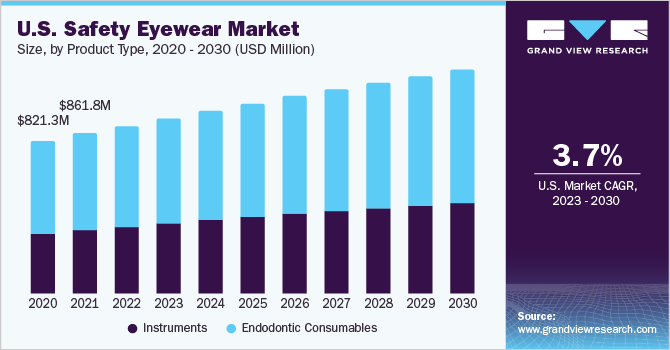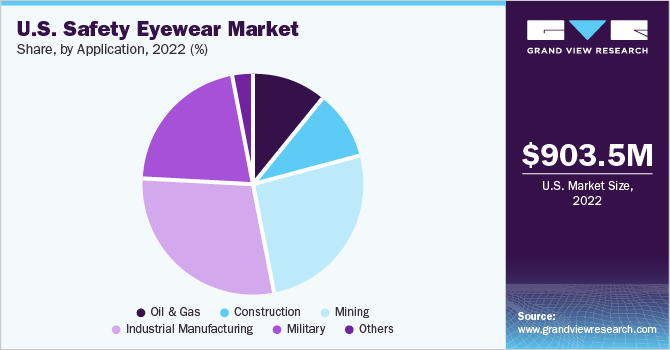
The U.S. safety eyewear market size was valued at USD 903.5 million in 2022 and is expected to grow at a compound annual growth rate (CAGR) of 3.7% from 2023 to 2030. The rising implementation of safety regulations is contributing to market growth. The U.S. has implemented numerous workplace safety regulations through authorities such as the occupational safety and health administration (OSHA). These organizations aim to protect the workforce from injuries and loss of life in hazardous work conditions. Safety regulations have greatly reduced the risk of loss of life in many occupations by taking legal punitive action against defaulters. Safety standards also extend to devices and equipment used by the workforce on a regular basis, such as clothes, boots, gloves, helmets, and eyewear.

The Occupational Safety and Health Administration, a large regulatory agency of the United States Department of Labor, has spelled out standardizations that every manufacturer needs to follow while manufacturing personal protection equipment (PPE). The directive aims to ensure that the PPE meets quality levels and safety standards by setting safety requirements, along with conditions for its placement on the market and free movement within the European market. The directive covers any equipment, device, or appliance that is designed to be held or worn by an individual for protection against health and safety hazards. These favorable regulations are expected to drive the use of personal protective equipment, including safety eyewear, in the forecast period.
Caring for eyes at the workplace is not restricted only to industrial laborers. People who spend long hours working on laptops or computers can experience varying levels of discomfort in their eyes. Spending long hours focusing on a screen can cause fatigue, eye strain, and headaches. It could also leave the eyes red, causing them to become dry due to a lack of blinking. According to Baucsh+Lombhis, this is owing to the fact that mobile screens, computer screens, and other digital displays reduce the blink rate of a person by as much as 66%. Continued usage of smartphones, computers, and other screens can also cause sleep disturbances, pain in the neck, wrist, and back, digital dementia, chronic tiredness, and many other ailments, which could drive the need for safety eyewear.
Despite the introduction of smart eyewear and other technologies that help correct visual impairment, blindness remains a major risk for people exposed to such work conditions. To safeguard their workforce, many companies-especially those with a contractual workforce-are now providing safety eyewear, in addition to other basic safety equipment. This will continue to benefit the market. In addition, various stringent regulations have been laid by the U.S. Department of Labor and OSHA in U.S., which has positively impacted the demand for safety eyewear. Rising awareness regarding employee safety has also augmented market growth. According to the National Institute for occupational safety and health (NIOSH), the majority of eye injuries are caused due to scraping of the eye or small objects or particles striking the eye such as wood chips, metal silvers, cement chips, and dust.
The safety eyewear market is expected to grow in the U.S. in the coming future. Increased awareness about eye safety among U.S. workers and corporations leads to a standardized market that follows industry regulations. In addition, the introduction of new materials such as Trivex is revolutionizing the industry; these materials are made from urethane polymers and are easier to be molded into prescription eyewear than polycarbonates are generally injection mold based. Furthermore, with an increase in the number of customers purchasing through online platforms, companies now have the chance to sell their products online and reach a considerable number of consumers anywhere in the world.
A significant role is played by the e-commerce retail channels in the distribution of safety eyewear and is expected to have a significant portion of the market revenue. Online sales channels allow consumers to explore a wide range of products at a single location without having to physically visit retail stores. E-commerce retail sales are predicted to increase significantly in the next few years as a result of rising consumer expenditure, a growing population, and more internet access. Furthermore, the emergence of mobile shopping applications and the availability of secure and simple payment methods are adding to the expansion of the online retail business. These trends are expected to positively impact the safety eyewear market during the forecast period.
The non-prescription segment dominated the market with a higher share of over 60% in 2022. Non-prescription safety glasses, majorly familiar as "Plano" lenses, are designed to be used by people who do not need glasses to prevent vision issues at the worksite. In situations where visual safety is a concern, prescription safety glasses are worn in place of the user's regular glasses. Non-prescription safety glasses can be worn on top of the wearer's regular corrective lenses as an alternative to prescription safety eyewear. Non-prescription safety eyewear is used mainly by laborers (day shift), city facility management (civic) workers, police and military, and heavy machinery operators. Since the number of individuals requiring corrective lenses is lower, the market for non-prescription safety eyewear is expected to grow at a higher rate over the forecast period. In addition, low cost and greater market availability are among the major factors driving the non-prescription safety eyewear market.
The prescription segment is anticipated to register a higher CAGR of 3.9% in the forecast period. Prescription safety eyewear is mainly used by engineers, technicians, scientists, academicians, specialists/professionals, artisans, and some sports/adventure enthusiasts. The demand for corrective lenses by white-collared professionals is expected to increase in the near future. Due to their premium cost, the value of the prescription segment is expected to rise further by the end of the forecast period. Several end users such as lab technicians & scientists, physicians, dentists, orthopedics, and sports/adventure enthusiasts are exposed to UV rays at the workplace. UV safety eyewear helps completely block all UV light frequencies. Additionally, several UV safety eyewear is tinted to allow certain color frequencies to be more visible than others.
The industrial manufacturing segment led the market with the highest share of over 25% in 2022. Industrial manufacturing comprises a range of operations, such as processing, assembling, and finishing, which expose workers to harmful chemicals, dust particles, and dangerous light radiations. This is increasing the demand for safety wear in the industrial manufacturing industry. Operations that involve considerable risk of eye injuries in industrial manufacturing include chiseling, drilling, hammering, sanding, chipping, spraying, grinding, smelting, cutting, and welding. Moreover, there is a high possibility that workers who are engaged in making safety glasses may be exposed to hazards such as heated plastics, chemicals, high pressure, electricity, sharp cutting edges, and falls. Therefore, safety organizations have laid down several standards & guidelines.

The mining segment is anticipated to grow with a faster CAGR of 3.9% over the forecast period. There have been significant improvements made for the regulation of mining because it is a significant industrial sector in many regions of the world, especially the U.S. Therefore, mining companies have been imposing strict guidelines to protect their workers from eye injuries caused at minefields. The mining industry is characterized by the presence of various sub-industries such as coal mining, iron ore mining, non-metallic mineral quarrying, gold & silver mining, and others. Thus, distinct types of safety eyewear products are required for different mining operations. For instance, safety glasses with side shields are suitable for most mining operations, while goggles are not recommended for below-ground mining operations unless a particular operation poses a risk of chemical splash hazard.
Key players operating in the market are adopting various steps to increase their presence in the market. These steps include strategies such as partnerships, mergers & acquisitions, global expansion, and others. Some of the initiatives include:
Some of the prominent players i n the U.S. safety eyewear market include:
Report Attribute
Details
Revenue forecast in 2030
USD 1,207.5 million
Growth rate
CAGR of 3.7% from 2023 to 2030
Base year for estimation